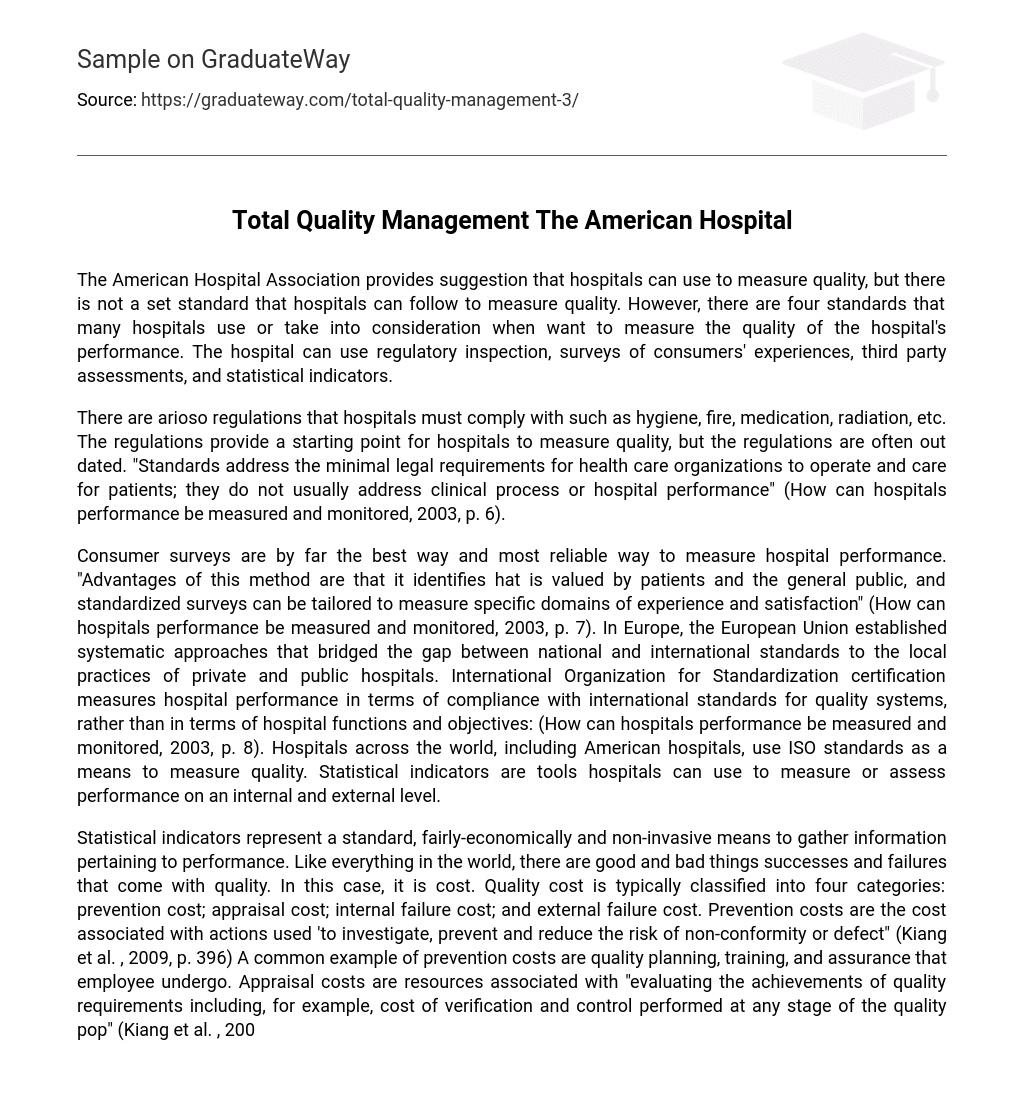The American Hospital Association provides suggestion that hospitals can use to measure quality, but there is not a set standard that hospitals can follow to measure quality. However, there are four standards that many hospitals use or take into consideration when want to measure the quality of the hospital’s performance. The hospital can use regulatory inspection, surveys of consumers’ experiences, third party assessments, and statistical indicators.
There are arioso regulations that hospitals must comply with such as hygiene, fire, medication, radiation, etc. The regulations provide a starting point for hospitals to measure quality, but the regulations are often out dated. “Standards address the minimal legal requirements for health care organizations to operate and care for patients; they do not usually address clinical process or hospital performance” (How can hospitals performance be measured and monitored, 2003, p. 6).
Consumer surveys are by far the best way and most reliable way to measure hospital performance. “Advantages of this method are that it identifies hat is valued by patients and the general public, and standardized surveys can be tailored to measure specific domains of experience and satisfaction” (How can hospitals performance be measured and monitored, 2003, p. 7). In Europe, the European Union established systematic approaches that bridged the gap between national and international standards to the local practices of private and public hospitals. International Organization for Standardization certification measures hospital performance in terms of compliance with international standards for quality systems, rather than in terms of hospital functions and objectives: (How can hospitals performance be measured and monitored, 2003, p. 8). Hospitals across the world, including American hospitals, use ISO standards as a means to measure quality. Statistical indicators are tools hospitals can use to measure or assess performance on an internal and external level.
Statistical indicators represent a standard, fairly-economically and non-invasive means to gather information pertaining to performance. Like everything in the world, there are good and bad things successes and failures that come with quality. In this case, it is cost. Quality cost is typically classified into four categories: prevention cost; appraisal cost; internal failure cost; and external failure cost. Prevention costs are the cost associated with actions used ‘to investigate, prevent and reduce the risk of non-conformity or defect” (Kiang et al. , 2009, p. 396) A common example of prevention costs are quality planning, training, and assurance that employee undergo. Appraisal costs are resources associated with “evaluating the achievements of quality requirements including, for example, cost of verification and control performed at any stage of the quality pop” (Kiang et al. , 2009, p. 1396). Common examples of appraisal costs are quality audits, inspections, and various acceptance tests. Internal failure costs are costs that arise within the organization due to defects or Nan-conformist’s of the quality loop.
The authors used the example of the resources used to complete replacement work and cost of scraps because of a defect caused by an internal design mistake. External failure costs are “cost arising after delivery to a customer/user due to non-conformist’s or defects, which may include the cost of claims against warranty, replacement, and consequential losses and valuation of penalties incurred” (Kiang et al. , 2009, p. 1396). In the case of Memorial hospital, external failure costs will likely not be a cost it will incur in measuring quality.
Total quality management (TTS) is an approach used by business around the world to measure and provide quality service. There are eight ideas or approaches associated with TTS: focus on the customer; quality function deployment; responsibility for quality; team problem solving; employee training; fact-based management; and philosophy of continuous improvement. By implementing some of the components, Memorial can deter ensure it will provide quality healthcare. Focusing on the customer encompasses the consideration of internal and external customers to improve the level of quality care provided.
The authors used the example of a hospital laboratory categorizing the physician who requested the lab as a customer. “Thus, a customer can be anyone, whether inside or outside an organization, who receives the output from an activity or process” (Venturesome & White, 2013, sec. 4. 4). When using this approach, Memorial hospital can consider the voice of the customer to determine the true needs of both internal and external customers. Listening to the voice of the customer is also a great way for Memorial to determine the quality of the services they provide.
Memorial can use the feedback received to develop and implement quality function deployment (SF). “SF is one method that can be used to make that transformation by relating customer needs and expectations to specific design characteristics through a series of grids or matrices” (Venturesome & White, 2013, sec. 4. 4). Another TTS method that Memorial can use to provide quality healthcare is to make the organization as a whole responsible for providing quality care. Each individual working for Memorial contributes to the level of service the hospital provides.
This method makes all of those individuals responsible regardless of the position the employee holds. This means that quality healthcare is a collective effort for janitors, cooks, doctors, and nurses to contribute to and ensure patient satisfaction. Memorial can improve its quality of care and promote effective quality improvement by: “developing the right culture for quality to flourish; attracting and retaining the right people to promote quality; devising and updating the right-in house processes for quality improvement; ND giving staffed right tools to do the job” (Meyer et al. 2004, p. 6). Many of the top-performing hospitals create a degree of commitment and motivation to providing high quality healthcare. By creating such environment and providing the resource needed to promote quality healthcare, Memorial will improve its overall customer satisfaction and quality.





